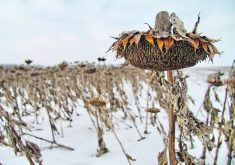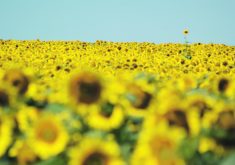MEDICINE HAT — Sunflower acres in Saskatchewan aren’t huge but a producer organization that supports the sector says there is potential to expand the crop for oilseed, confectionary and birdseed markets.
Elaine Moats, Saskatchewan Sunflower Committee vice-president, said sunflowers are native to the province, which gives them natural attributes.
“It’s our only native oilseed crop,” she said, adding it was first cultivated by Indigenous groups and then other varieties were developed following European settlement of Western Canada.
Russia and Ukraine are now the biggest growers of the crop globally. About 90 percent of domestic production is in Manitoba, with some also in Saskatchewan and Alberta.
Read Also

Russian wheat exports start to pick up the pace
Russia has had a slow start for its 2025-26 wheat export program, but the pace is starting to pick up and that is a bearish factor for prices.
There is room for growth of the crop in Saskatchewan, where current production is mostly aimed at the oilseed market, said Moats.
Even before canola was introduced, Saskatchewan growers had access to oilseed crushers, she said. There were two in Manitoba and four in North Dakota. Some have switched to canola as the focus of farmers has also shifted.
As sunflower varieties were developed with a different oil profile, they weren’t as adapted to Saskatchewan growing conditions. That affected sunflowers’ popularity. Production went from more than 61,000 acres in the 1990s to less than 8,000 acres now.
New varieties are being developed and the burgeoning birdseed market is proving lucrative, added Moats, and there are birdseed processors in all three prairie provinces.
“There has also been development of an earlier maturing sunflower variety out of Saskatoon’s Agriculture and Agri-Food research station.”
The short season varieties can mature in 105 to 110 days so the crop has spread outside its traditional southeastern range in Saskatchewan, said Moats. Full season varieties mature in 113 to 115 days.
The committee is working with researchers in North Dakota to develop new varieties that may help growers regain some traction.
One variety, called Honeycomb, is still a year or two from release. Moats said there are two more in development that could be better suited for provincial growing conditions.
“These varieties are going to open up the oil market back to us again,” she said.
Sunflowers can do well in dry conditions. A deep root system can tap into soil moisture reservoirs and reach deep nutrient deposits.
“If you are in a chronically dry area — the dry brown soil zones in the southwestern corner of the province — it’s not always a great fit,” said Moats. “But for most areas of the province, you can use it to help manage your soil moisture conditions.”
The crop is resistant to fusarium and does well under irrigation. As for crop rotations, sunflowers work best in place of other oilseeds and particularly well over a four-year rotation.
Research is also being conducted in Saskatchewan on how sunflowers do in combination with cover crops, and on their use for livestock feed and silage, added Moats.
















